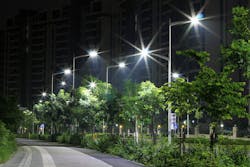A group of environmental scientists from England have gathered photos of Earth taken from the International Space Station over the last decade showing a broad trend across Europe of nighttime artificial lighting veering much more toward the blue spectra than previously.
Writing in the journal Science Advances, they warn that the shift “is widely increasing the risk of harmful effects to ecosystems.”
The observation of more pronounced blue spectra does not in itself come as a surprise, given that many outdoor LED luminaires tend to emit more blue-rich wavelengths than the lights they have been replacing such as low-pressure sodium and others.
But as the team from the University of Exeter noted, the photographs taken by astronauts in two timeframes — from 2012 to 2013 and from 2014 through 2020 — provide what the scientists say is the first broad-scale portrayal of the bluing actually happening. The astronauts took the photos using digital SLR cameras, and the scientists analyzed the spectral content captured in the images.
“While data on spatial and temporal variation in the intensity of artificial lighting have been available at a regional and global scale, data on variation in its spectral composition have only been collected for a few locations, preventing variation in associated environmental and human health risks from being mapped,” said the team from Exeter’s Penryn campus.
“Here, we use imagery obtained using digital cameras by astronauts on the International Space Station to map variation in the spectral composition of lighting across Europe for 2012–2013 and 2014–2020,” continued the team, led by Alejandro Sánchez de Miguel, who is also affiliated with Madrid’s Universidad Complutense. “These show a regionally widespread spectral shift, from that associated principally with high-pressure sodium lighting to that associated with broad white light-emitting diodes and with greater blue emissions. Re-expressing the color maps in terms of spectral indicators of environmental pressures, we find that this trend is widely increasing the risk of harmful effects to ecosystems.”
The authors point out that the trend has been uneven within Europe.
“Countries that have experienced less marked changes include Austria and Germany,” they note. “These countries are traditionally very conservative in their lighting conversions. For example, Germany likely has the highest proportion of gas lighting of anywhere, and a lot of fluorescent and mercury-vapor lights are still in use, so the spectral change with LED transition is less marked.” Conversely, there have been marked increases in blue in Italy, Spain, the UK, Ireland, and Romania, they wrote.
In places where it is happening, the blue spectra has “substantial biological impact” on humans and ecosystems, they noted. While footnoting previous studies showing effects on bats, invertebrates, and others, the authors singled out examples which they analyzed.
The team pointed out detrimental effects on the production of melatonin among many organisms. Melatonin is a hormone associated with sleep and the circadian cycle in many animals as well as in humans. They also noted that excess artificial light at night, especially in the blue spectrum, is undermining the ability of not just humans but animals to see stars, a detriment for creatures that use stars for navigation. And they wrote that blue wavelengths are undermining the light-determined (“phototaxic”) activities of moths and other insects.
The authors also questioned whether some of the benefits of LED streetlighting are overstated. For example, the energy savings is not always substantial, depending on the specific case, they note.
In a U.S.-based commercial market effort, the DesignLights Consortium has established its LUNA Technical Requirements to simplify the ability to specify and implement outdoor lighting products that mitigate these concerns for humans and ecosystems while reducing energy consumption, by delivering appropriate light distribution, intensity, and color in the application for which they are intended. LEDs Magazine will follow up on outdoor lighting regulations and programs in other regions in the coming year.
—
LEDs Magazine has written many stories on the positive and negative effects of the blue spectra, and outdoor lighting on night skies. Here are just a few:
There’s still some disagreement about commercializing circadian lighting principles
Indoors, tunable lighting could help steady seniors
Outdoors, concerns arise about energy use due to overlighting
Turtle-friendly amber lighting also addresses dark-sky concerns
Informed local communities look for dark-sky approved fixtures
MARK HALPER is a contributing editor for LEDs Magazine, and an energy, technology, and business journalist ([email protected]).
For up-to-the-minute LED and SSL updates, follow us on Twitter. You’ll find curated content and commentary, as well as information on industry events, webcasts, and surveys on our LinkedIn page and our Facebook page.






